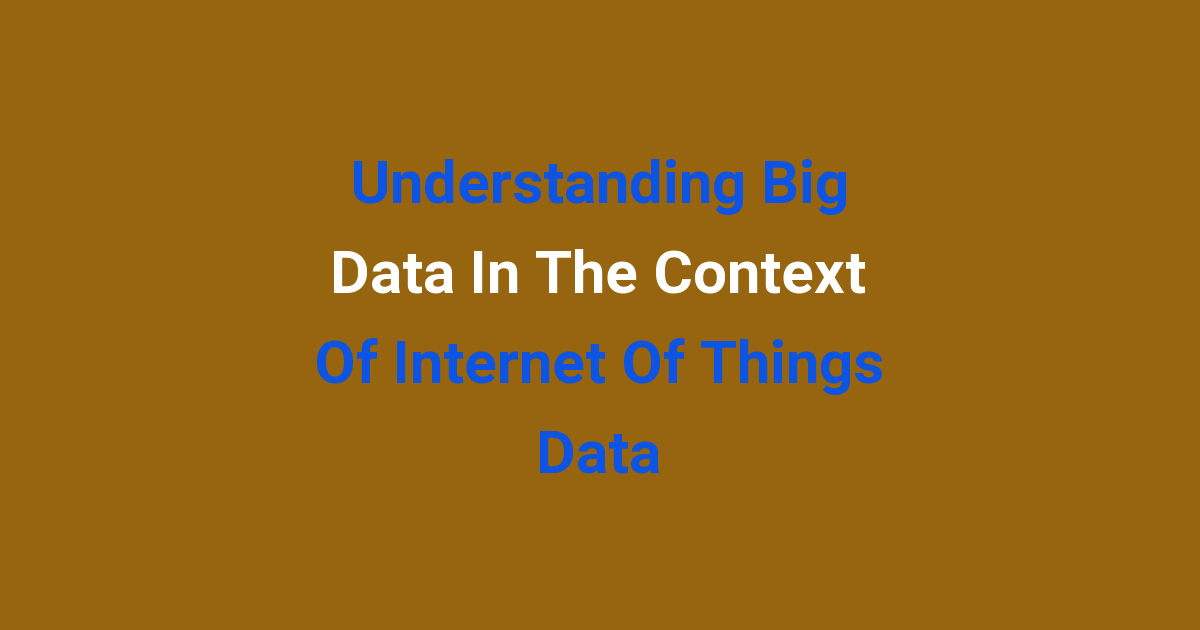Understanding big data in the context of Internet of Things (IoT) entails analyzing and interpreting vast amounts of data generated by interconnected devices and sensors.
Understanding Big Data in the Context of Internet of Things Data
Introduction
In today’s rapidly evolving technological landscape, the Internet of Things (IoT) has emerged as a game-changer, revolutionizing the way we interact with technology and data. The IoT refers to the network of interconnected devices and sensors that communicate with each other and with central systems, creating a vast web of data that can be analyzed and leveraged to drive insights and actions. At the heart of this data-driven revolution lies the concept of big data – the massive amounts of structured and unstructured data that is generated by IoT devices every second.
Problem Statement
While the IoT has unlocked unprecedented opportunities for innovation and efficiency, the sheer volume and complexity of data generated by IoT devices present a significant challenge. Traditional data processing tools and techniques are often inadequate to handle the scale and speed at which IoT data is generated, leading to bottlenecks, latency issues, and missed opportunities for real-time insights. This gap between data generation and data processing capabilities poses a critical challenge for organizations looking to fully harness the potential of IoT data.
Existing System
In the existing system, organizations typically rely on conventional data processing tools and technologies, such as relational databases and traditional data warehouses, to analyze IoT data. While these systems have served organizations well in the past, they are ill-equipped to handle the scale, variety, and velocity of IoT data. As a result, organizations often struggle to derive real-time insights from their IoT data, leading to delays in decision-making and missed opportunities for optimization and innovation.
Disadvantages
The limitations of the existing system are manifold. Traditional data processing tools lack the scalability and agility required to handle the massive volumes of IoT data generated in real time. This leads to bottlenecks, latency issues, and performance degradation, hampering organizations’ ability to derive actionable insights from their IoT data. Moreover, the complexity and variety of IoT data pose a significant challenge for traditional data processing tools, which are often designed to handle structured data and may struggle with unstructured and semi-structured data formats.
Proposed System
To address the limitations of the existing system, we propose the adoption of a modern big data processing framework that is specifically designed to handle the unique challenges of IoT data. This framework leverages distributed computing technologies, such as Hadoop and Spark, to process and analyze massive volumes of data in real time. By harnessing the power of parallel processing and in-memory computation, this framework enables organizations to derive actionable insights from their IoT data with minimal latency and maximum efficiency.
Advantages
The proposed system offers a host of advantages over the existing system. By leveraging distributed computing technologies, organizations can horizontally scale their data processing capabilities to handle the massive volumes of IoT data generated in real time. This enables organizations to derive real-time insights from their IoT data, leading to improved decision-making, operational efficiency, and customer experience. Moreover, the proposed system is designed to handle the variety and complexity of IoT data, allowing organizations to analyze structured, unstructured, and semi-structured data formats with ease.
Features
Some key features of the proposed system include:
– Scalability: The system can scale horizontally to handle the growing volumes of IoT data.
– Real-time processing: The system enables organizations to analyze IoT data in real time, leading to actionable insights.
– Compatibility with diverse data formats: The system is designed to handle structured, unstructured, and semi-structured data formats.
– Fault tolerance: The system is fault-tolerant, ensuring high availability and reliability of data processing operations.
Conclusion
In conclusion, the convergence of big data and IoT data presents both challenges and opportunities for organizations looking to harness the power of data-driven insights. By adopting a modern big data processing framework that is specifically designed to handle the unique challenges of IoT data, organizations can unlock the full potential of their IoT data and gain a competitive edge in today’s data-driven world. The proposed system offers a scalable, real-time, and versatile solution for processing IoT data, enabling organizations to derive actionable insights and drive innovation and efficiency. Through the adoption of this framework, organizations can pave the way for a future that is defined by data-driven decision-making and technological advancement.

